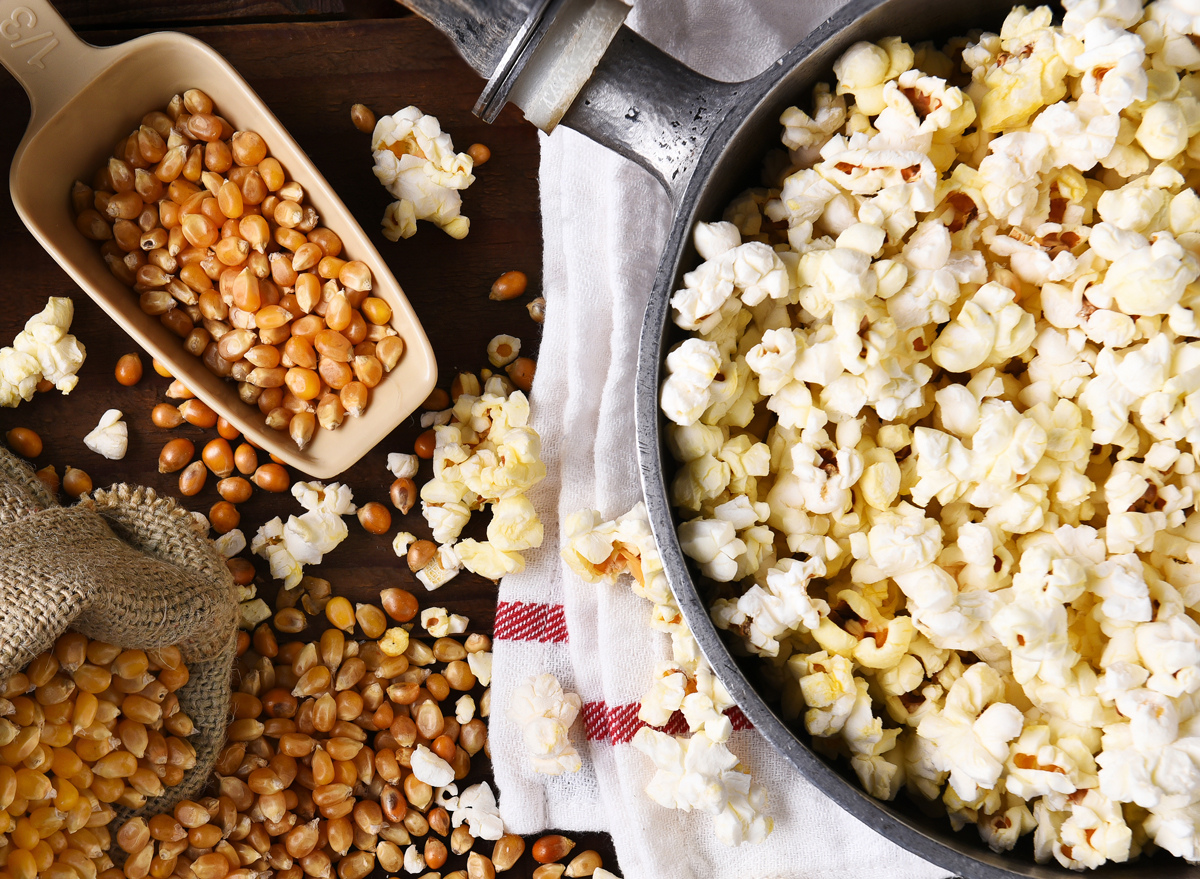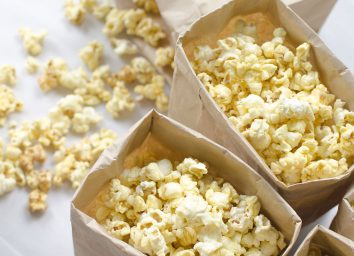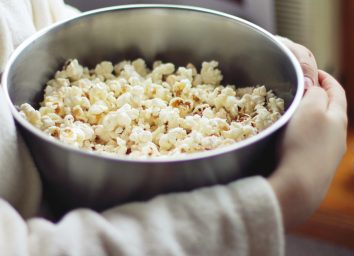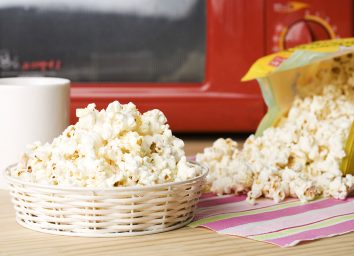The #1 Unhealthiest Way to Prepare Popcorn, According Dietitians

Despite being synonymous with movie theater snacks, popcorn isn’t in the same league as treats like candy and soda—at least when it comes to nutrition. Popcorn can actually be good for you.
“Popcorn can be an excellent, nutrient-rich snack food depending on how it is prepared. Popcorn is a whole grain, which is a little-known fact, and therefore an excellent source of fiber and polyphenols, which help fight free radical damage in the body,” says Trista Best, MPH, RD, LD, a registered dietitian at Balance One Supplements.
Although this light and airy snack is high in fiber and low in calories, like Best mentioned, popcorn can easily be made into an unhealthy bite if made improperly. To make sure you can actually reap the benefits of popcorn, you have to make sure you don’t prepare it in the unhealthiest way possible: covered in butter and salt.
Why too much butter and salt is the unhealthiest way to prepare popcorn
“A common way people may be preparing popcorn that detracts from its health benefits is adding a lot of butter on top,” says Kylie Ivanir, MS, RD, a registered dietitian with Within Nutrition.
While being incredibly delicious, butter isn’t going to do your body any favors when it’s poured over popcorn; in fact, it may even encourage fat gain.
“Butter is high in saturated fat which, when combined with carbohydrates, creates a ‘sweet fat.’ This highly palatable combination can result in over-consumption, interfering with the body’s ability to regulate appetite and leading to enhanced cravings. This combination of carbohydrates and saturated fat can also put the body in fat-storing mode,” says Ivanir. (Related: 20 Foods Ruining Your Weight Loss Goals.)
Just one tablespoon of butter is 100 calories and has 7 grams of saturated fat. And if you’re using a store-bought popcorn topping like Orville Redenbacher’s Popping & Topping Buttery Flavored Oil, you’ll only be consuming 2 grams of saturated fat but 120 calories for every serving.
While making your own buttery popcorn at home gives you a little more wiggle room with calories per serving, the same can’t be said with microwave popcorn. Some butter-flavored microwave popcorn bags have 180 calories per serving when the same bag of butter-free popcorn is just 80 calories. So opting for lightly seasoned popcorn over buttered will save you 100 calories per serving.
You can make matters even worse if you add some sugar to your recipe to make kettle corn.
“Popcorn is easily turned unhealthy with the addition of oil, butter, and white sugar [when making kettle corn]. What was a high fiber, filling snack packed with vitamins and antioxidants is now laden with pro-inflammatory fat calories and white sugar,” says registered dietitian Theresa Gentile, MS, RDN, Owner of Full Plate Nutrition and Media Spokesperson for the NY State Academy of Nutrition and Dietetics. “I’ve even seen the addition of corn syrup and maple syrup, which instantly makes this considered dessert,” says Gentile.
How to prepare popcorn in a healthy way
Just because popcorn is commonly prepared in an unhealthy way doesn’t mean it’s difficult to find and eat a better-for-you version.
“You can make popcorn at home flavorful and delicious with some simple tweaks,” says Vanessa Rissetto, MS, RD, CDN, registered dietitian and Co-Founder of Culina Health.
For flavorful, healthy popcorn, you have to start with a solid base, and that involves popping your own:
“One of the best ways to make popcorn is to air pop the kernels on the stove, rather than buying pre-packaged microwavable popcorn, which may contain added oils, salt, or artificial flavoring. The lining of microwave bags may also contain harmful chemicals,” says Ivanir. (Related: The #1 Reason Why You Shouldn’t Eat Microwave Popcorn.)
Once you make your air-popped corn, it’s time to season it sans butter.
“Popping your own popcorn on the stove allows you to control the toppings. People can add fun toppings to their popcorn for a kick, such as cinnamon for some sweetness or nutritional yeast for a cheesy flavor,” says Ivanir.
Rissetto recommends using 1 tablespoon of olive oil (which is loaded with healthy fats) for 1 cup of kernels and adding seasonings like parmesan cheese, crushed red pepper flakes, and even tabasco.
“To preserve popcorn’s health benefits, I recommend adding a drizzle of olive oil and a little sea salt or adding nutritional yeast, which has a cheesy, savory flavor,” says Gentile. For more ideas, don’t miss This One Trick Will Make Your Popcorn Taste Better.
For more healthy eating news, make sure to sign up for our newsletter!








